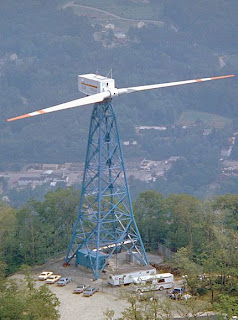Using the wind as an energy source is not development during the latest decades. Even in ancient times methods were developed to take advantage of the force of the wind. At sea, sails were used to utilize wind’s power in order to propel boats. The invention of windmills was a significant development for any society. The power of the wind alleviated the sweat of the grinding process, as it replaced mulls and bare hands as the drivers. The windmills not only made the core process less costly, it also dramatically improved working conditions and created an industry for windmill production.
 |
Persian vertical axis windmill |
The ancient panemones
The first genuine record of a built wind driven onshore mill was noted in the 9th century in Persia (what is now called Afghanistan). This ancient windmill is called a panemone. A panemone is a device with wind-catching vanes that move in the same direction as the thrusting force of the wind (this is called ‘drag’). This is in contrast to the motion of a propeller, whose blades move at 90 degrees to the thrust of the wind (this is called ‘lift’). Panemones have a vertical axe and its design typically includes stop pegs to control panels as they catch wind. A stop peg - placed at one side of each panel - prevents the panel from rotating as the wind blows against the side of the panel. The Persian model had sails covered in reed matting or cloth material that rotated a vertical shaft. The first historical documentation of a panemone in China dates from 1219 AD.
European wind mills
 |
| Doesburgermolen, built around 1620 Photo by Rens Kokke |
Wind Turbines
While windmills were increasingly popular, their reliability on the presence of wind, was always a huge disadvantage when compared to watermills. During the 18th and 19th century of the industrial revolution, the popularity of mind mills declined as wind driven labor was superseded by the introduction of the more superior steam engines. It was only in the end of the 19th century that wind mills had an answer on its future. New scientific knowledge in the field of electricity, led to the first experimental wind turbines that generated electricity. The first serious wind turbine was build in 1888 in Cleveland (Ohio, United States) and generated 12 KW. In 1890 An experiment by the scientist Poul La Court to illuminate a high school by a mixture of oxygen and hydrogen caused an impetus for wind turbines, as the production of electricity was necessary for hydrogen to split from water. Around 1900 there were like 2500 wind turbines in Denmark. 40 years later, In 1931 a vertical axis wind turbine (VAWT) was developed, called Darrius. The advantage of the vertical axis is the low maintenance costs, but In practice horizontal models tend to be more efficient. It were the horizontal axis wind turbines (HAWT’s) that became increasingly popular at rural areas across the United States. This expansion lasted until the end of the thirties, when most farms got wired to the grid. In the mean time the accumulation of technological knowledge on aerodynamics led to greater capabilities. In 1941 a 1.25-megawatt Smith-Putnam turbine was placed on the mountain Grandpa’s Knob, Vermont, United States.
 |
| The NASA/GE Mod-1 Wind Turbine could generate 2MW of electricity |
As yet, the wind is an untamed, and unharnessed force; and quite possibly one of the greatest discoveries hereafter to be made, will be the taming, and harnessing of it.
— Abraham Lincoln, 1860
Recent developments
 |
| World's record holding wind turbine from Energon generates 7,58MW |
References
- Bloomberg (2011) Press letter: Wind Turbine Prices fall to their lowest in recent year (released on 7 February 2011)
- Jan Giesen (2011) De Windturbine (viewed on 28 June 2011)
- Ragheb M. (2011) Lecture Notes on: Wind Power Systems, para 'wind generators history' Univ. of Illiionois at Urbana-Champaign (published on 31 January 2011, viewed online on 30 June 2011)
- Upwind (2011) Design limits and solutions for very large wind turbines - A 20 MW turbine is feasible (Published March 2011)
- Wikipedia (2011a) Windmolen (Viewed online on 30 June 2011)
- Wikipedia (2011b) NASA wind turbines (Viewed online on 30 June 2011)
Other sources
- Norwegian University of Science and Technology (NTNU) The historical development of the wind turbine.





